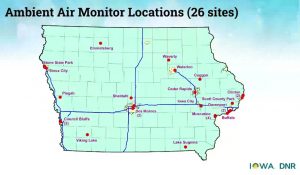State signs air monitoring contract with state Hygienic lab
June 18th, 2025 by Ric Hanson
(Radio Iowa) – The state Environmental Protection Commission approved a new contract Tuesday with the University of Iowa Hygienic Lab to continue running air monitors. D-N-R Air Quality Bureau environmental specialist Wendy Walker told the Commission some of the monitoring is done to see if the state is meeting the E-P-A guidelines. “We also want to provide real time air pollution data. You’ve seen some of the pictures from the Canadian wildfires as it comes into the air, that is provided under this contract,” she explains. “We want to make informed decisions about what’s going on, what our background values are.” The contract is just under one-point-eight-four million dollars, up three-thousand dollars from last year. Walker says the monitors go beyond the basic air testing.
“We also have special purpose monitors that will provide some more of the public reporting data that we’re looking for, as well as background values, air quality mapping and compliance issues,” Walker says. Walker says they have the biggest focus on where the people are. “We monitor a large public large populated areas in your cities. We are also looking to see where ozone is coming in, down wind ozone monitors. We’re looking at what comes across our borders and the transportation of air pollutants,” Walker says. “Unfortunately, air pollution doesn’t pay attention to jurisdictional boundaries between countries or states or anything like that. So we want to know what’s coming in from where and what we’re actually sending out too.” Walker says some of the pollution they monitor is very small.

Iowa DNR graphic
“We have what we call particulate matter, ten microns and then two-point-five microns or less in size. A human hair is on average. 50 to 70 microns in diameter. So if you think about, look at your hair, it’s 50 to 70 microns. We’re looking at ten microns or less for two-and-half microns or less,” she says. Walker says the Hygienic lab will supply data and will also keep an eye on the monitors to be sure they are working correctly. “One time we had a monitor that went down because of bees. So you do have to go in and make sure that they are running OK and make sure that you have no insects or any other type of issues,” Walker says.
Walker says they have use the State Hygienic lab to test air quality for more than 30 years.





